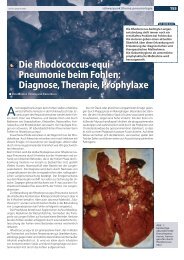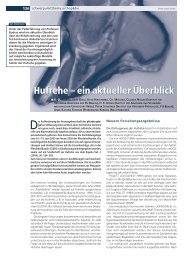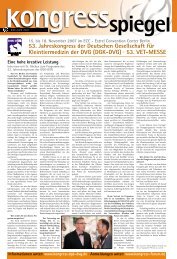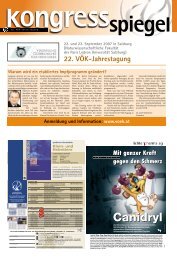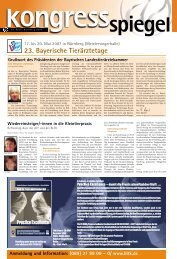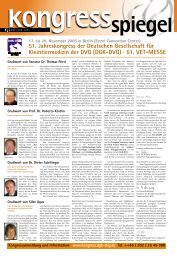XVII. Tagung über Pferdekrankheiten im Rahmen der EQUITANA
XVII. Tagung über Pferdekrankheiten im Rahmen der EQUITANA
XVII. Tagung über Pferdekrankheiten im Rahmen der EQUITANA
Sie wollen auch ein ePaper? Erhöhen Sie die Reichweite Ihrer Titel.
YUMPU macht aus Druck-PDFs automatisch weboptimierte ePaper, die Google liebt.
Ausgabe 6·2006 Vorschau wissenschaftliches Programm/Scientific Program Forecast kongressspiegel 3<br />
Potential use of micro-array technology (bio-puce) in<br />
the diagnosis of inflammatory disor<strong>der</strong>s in the horse<br />
Pierre Lekeux, Aurélie Thomas, Eve Ramery, Tatiana Art, Rodrigue Closset, Fabrice Bureau, Liege, Belgium<br />
The performance of a competition<br />
horse is based on genetic potential,<br />
excellent health and opt<strong>im</strong>al<br />
training. Nowadays, two ways to evaluate<br />
performances exist: performance<br />
control itself and veterinary<br />
monitoring. The latter classically<br />
consists of a clinical check-up and<br />
complementary analyses, as for<br />
example blood analysis, radiography,<br />
or ultrasound. In spite of the regularity<br />
of veterinary check-ups, in<br />
many situations health problems<br />
cannot be prevented or controlled in<br />
t<strong>im</strong>e, which has a negative influence<br />
on the horses’ performances. So for<br />
instance pathological conditions are<br />
detected when they have already<br />
induced irreversible lesions, e.g.<br />
when joint inflammation has already<br />
started to damage the joint cartilage.<br />
It also occurs when the pathology is<br />
not determined with sufficient accuracy:<br />
the proposed treatment is then<br />
non-specific and often not very efficient.<br />
The perfect example here is<br />
inflammation caused by mechanical<br />
stress, allergy or infection: the symptoms<br />
are often s<strong>im</strong>ilar, but the three<br />
aetiologies require specific treatment.<br />
New technology „DNA chip“<br />
In or<strong>der</strong> to propose solutions for<br />
the l<strong>im</strong>iting factors of medical monitoring,<br />
a tool, born from mo<strong>der</strong>n<br />
technologies, is being developed in<br />
the equine species. This is the microarray<br />
or bio-chip, also called a „DNA<br />
chip“ in English literature. This new<br />
technology should permit:<br />
• the detection of certain conditions<br />
earlier, i.e. before they induce<br />
lesions and disrupt performances;<br />
• the more specific determination of<br />
the origin of the conditions, in or<strong>der</strong><br />
to use a better targeted, and thus,<br />
more efficient therapy;<br />
• the detection of horse’s predisposition<br />
to certain conditions by genetic<br />
profiles, in or<strong>der</strong> to set up appropriate<br />
preventive care.<br />
Micro-arrays technology permits<br />
a quick determination of the level of<br />
gene expression by analysing a sample<br />
of the horse’s cells. Genes can be<br />
normally-, but also un<strong>der</strong>- or overexpressed.<br />
In the ideal situation, each<br />
gene should be expressed in the function<br />
of the horse’s needs in each<br />
moment. If the gene is un<strong>der</strong>expressed,<br />
too little of the corresponding<br />
proteins will be synthesised.<br />
On the contrary, if the gene is<br />
over-expressed, too much of the corresponding<br />
proteins will be synthesised.<br />
Proteins are only fully efficient<br />
when synthesised in the exact<br />
amounts needed, at the right<br />
moment and at the right place. Too<br />
high levels of proteins are therefore<br />
just as bad as too low levels.<br />
Instant <strong>im</strong>age of cell gene<br />
expression<br />
The middle term development of<br />
micro-arrays applied to sport horse’<br />
veterinary medicine is motivated by<br />
the many advantages offered by this<br />
new technology.<br />
Nowadays, the genetic molecular<br />
methods can only analyse one gene<br />
at a t<strong>im</strong>e. The new micro-arrays,<br />
thanks to miniaturization techniques,<br />
are able to analyse several<br />
thousands of genes on only one glass<br />
strip a few cent<strong>im</strong>etres wide. Thus it<br />
is now possible to un<strong>der</strong>stand interactions<br />
between different genes,<br />
many of which had been unknown<br />
until today. This makes the complete<br />
un<strong>der</strong>standing of the horse’s pathology<br />
much easier for the veterinary<br />
practitioner.<br />
Micro-arrays give an instant<br />
<strong>im</strong>age of the exact way each cell gene<br />
is expressed. This ensures that un<strong>der</strong>or<br />
over-expressions of genes are easily<br />
detectable. The gene expression<br />
level can thus be measured in different<br />
situations like, for instance,<br />
before and after effort.<br />
The basis of the approach<br />
By studying the expression level<br />
of each gene, biological micro-arrays<br />
allow the diagnosis and the characterization<br />
of a pathological condition<br />
at its <strong>im</strong>mediate source. The information<br />
obtained brings a very precise<br />
diagnosis because it is consi<strong>der</strong>ing<br />
every gene. This is nevertheless not<br />
The use of scintigraphic examination<br />
in sport horses with unexplained lameness<br />
Sue Dyson, Suffolk, United Kingdom<br />
Nuclear scintigraphy can be used<br />
in a variety of different clinical situations<br />
to facilitate the diagnosis of<br />
lameness and poor performance in<br />
sports horses:<br />
• Pain localised to a region, but no<br />
detectable radiographic abnormality,<br />
• Partial <strong>im</strong>provement to local analgesic<br />
techniques, suspected bone<br />
injury, but unable to identify lesion,<br />
• For the determination of the likely<br />
significance of subtle radiographic<br />
abnormalities,<br />
• If there are no localising clinical<br />
signs and there is no or little<br />
response to local analgesia,<br />
• Clinical signs suggestive of fracture<br />
but no localising clinical signs,<br />
• Poor performance but no localising<br />
clinical signs,<br />
• Episodic lameness that cannot be<br />
reproduced.<br />
It is however crucial to recognise<br />
that increased radiopharmaceutical<br />
uptake (IRU) is not necessarily synonymous<br />
with pain causing lame-<br />
ness. Recognition of common sites of<br />
asymptomatic incidental regions of<br />
IRU is crucial for accurate diagnosis.<br />
Examples<br />
Pain localised to a region, but no<br />
detectable radiographic abnormality.<br />
E.g., foot pain:<br />
• identification of focal IRU in lateral<br />
pool phase <strong>im</strong>ages in the region of<br />
the deep digital flexor tendon<br />
(DDFT),<br />
• identification of IRU at the site of<br />
insertion of the DDFT on the distal<br />
phalanx; solar <strong>im</strong>ages are usually<br />
most sensitive,<br />
• identification of focal IRU at the<br />
insertion of a collateral ligament of<br />
the distal interphalangeal joint on<br />
the distal phalanx; solar <strong>im</strong>ages are<br />
usually most sensitive,<br />
• identification of focal or diffuse<br />
IRU in the navicular bone.<br />
E.g., fetlock region pain:<br />
• identification of focal IRU in the<br />
prox<strong>im</strong>al epiphyseal region of the<br />
prox<strong>im</strong>al phalanx probably repre-<br />
possible in a s<strong>im</strong>ple blood sample, as<br />
only the molecules actually present in<br />
the blood are usable.<br />
As the diagnosis is extremely precise,<br />
the treatment is also. The<br />
approach consists of pharmacologically<br />
st<strong>im</strong>ulating the expression of<br />
the un<strong>der</strong>-expressed genes, and, conversely,<br />
provoking the inhibition of<br />
those that are over-expressed. This<br />
way only the proteins <strong>im</strong>plicated in<br />
the pathology are concerned by the<br />
treatment. The micro-arrays thus<br />
permit a fast and specific treatment<br />
of the horse in question. Thanks to<br />
their quick and adequate intervention,<br />
micro-arrays encourage the an<strong>im</strong>al’s<br />
healing, min<strong>im</strong>izing the risk of<br />
undesired side-effects.<br />
Micro-arrays diagnosis is not<br />
based on a detection of symptoms,<br />
but on a modification of the gene<br />
expression. This makes pathology<br />
detection possible even before the<br />
onset of its clinical manifestation.<br />
The physical entity of the horse is protected<br />
and its performances are less<br />
affected.<br />
Two l<strong>im</strong>iting factors still exist<br />
It is indeed possible to <strong>im</strong>agine a<br />
micro-arrays analysis on a regular<br />
base before and after training, in<br />
or<strong>der</strong> to verify the high-level sport<br />
horse’s health and to determine its<br />
potential predispositions to develop<br />
pathological conditions. The preventive<br />
measures can be adapted according<br />
to the characteristics and specific<br />
needs of every horse.<br />
Up to now, two l<strong>im</strong>iting factors<br />
exist in the development of the biological<br />
micro-arrays technology. The<br />
horse’s genome is not yet completely<br />
decoded. This means not all equine<br />
genes are currently un<strong>der</strong>stood.<br />
Nevertheless, research teams discover<br />
new genes every day. The<br />
equine genome will thus be completely<br />
decoded in the near future.<br />
The cost of a biological micro-array is<br />
still substantial and its use is still l<strong>im</strong>ited<br />
to scientific research. However,<br />
the price will drop dramatically in due<br />
course and the use of micro-arrays<br />
will certainly be affordable for moni-<br />
senting an incomplete sagittal fracture<br />
• identification of focal IRU in a<br />
condyle of the third metacarpal bone<br />
reflecting traumatically induced or<br />
stress-induced osseous pathology.<br />
E.g., metacarpal region:<br />
• identification of focal IRU in the<br />
prox<strong>im</strong>al palmar cortex of the third<br />
metacarpal bone, reflecting a palmar<br />
cortical stress fracture,<br />
• identification of focal IRU in the<br />
prox<strong>im</strong>al plantar aspect of the third<br />
metatarsal bone reflecting entheseous<br />
injury at the origin of the suspensory<br />
ligament.<br />
E.g., hock pain:<br />
• <strong>im</strong>provement in lameness after<br />
fibular & tibial nerve blocks but no<br />
response to intra-articular analgesia<br />
of the tarsocrural, centrodistal<br />
and tarsometatarsal joints; identification<br />
of IRU in the talus reflecting<br />
osteoarthritis, an incomplete<br />
parasagittal fracture of the talus or<br />
a developing osseous cyst-like<br />
lesion (OCLL).<br />
toring racing horses after its commercialisation.<br />
Examples to be seen<br />
The analysis is carried out on<br />
horse cells. These can come from<br />
blood, joint liquid puncture, tracheobronchial<br />
wash or uterine wash. The<br />
genetic material is extracted and put<br />
on the micro-arrays in the laboratory,<br />
in or<strong>der</strong> to be treated. Thanks to a very<br />
sophisticated technique, a characteristic<br />
picture of the studied genes’<br />
expression is obtained. This picture<br />
is then compared to one obtained<br />
from a known horse on the same<br />
micro-array. Every colour spot represents<br />
a specific gene. In the lecture<br />
we will show an example of two<br />
abnormally expressed genes.<br />
Applications<br />
Most applications of microarrays<br />
with sport horses are based on<br />
the analysis of the gene expression<br />
level in or<strong>der</strong> to detect un<strong>der</strong>- and<br />
over-expression. It then becomes<br />
possible to evaluate the adaptation of<br />
the horse to its training. For instance,<br />
genes corresponding to anti-oxidative<br />
enzymes such as glutathione peroxidase<br />
(GPx) can be analysed. The<br />
synthesis of this protein should be<br />
proportional to the horse’s needs<br />
before and after effort. Un<strong>der</strong>-expression<br />
of these genes produces oxidative<br />
stress and can lead to effortlinked<br />
muscular dystrophy. If such<br />
an un<strong>der</strong>-expression is detected, it<br />
could be compensated pharmacologically<br />
by specifically st<strong>im</strong>ulating the<br />
deficient gene’s expression. On the<br />
other hand, it is also possible to complement<br />
the an<strong>im</strong>al with anti-oxidants<br />
in its food on a daily basis, for<br />
instance. The horse should reach its<br />
best performances again, and recover<br />
its opt<strong>im</strong>um performance.<br />
According to the same principle,<br />
micro-arrays can also diagnose<br />
inflammation very precisely, by<br />
analysing joint liquid, for example.<br />
The evidence of the over expression<br />
of genes corresponding to proinflammatory<br />
mediators can indeed<br />
permit the characterisation of the<br />
exact type of inflammation (acute or<br />
chronic; mechanical, allergic or<br />
infectious;…). The <strong>im</strong>mediate concern<br />
is that the active principle to stop<br />
the inflammation process can be<br />
quickly identified. This way t<strong>im</strong>e is<br />
Partial <strong>im</strong>provement to local<br />
analgesic techniques, suspected bone<br />
injury, but unable to identify lesion.<br />
E.g., identification of IRU in the palmar<br />
aspect of the diaphyseal region<br />
of the third metacarpal bone after<br />
partial <strong>im</strong>provement to subcarpal<br />
nerve blocks of the palmar and palmar<br />
metacarpal nerves.<br />
E.g., identification of focal IRU in<br />
the distal row of carpal bones after<br />
partial response to subcarpal analgesia<br />
with or without a positive<br />
response to median and ulnar nerve<br />
blocks.<br />
For the determination of<br />
the likely significance of subtle<br />
radiographic abnormalities.<br />
E.g., subtle loss of opacity of the flexor<br />
cortex of the navicular bone, close to<br />
the sagittal ridge:<br />
• Significance of an OCLL,<br />
• Significance of focal modelling of<br />
an ossified cartilage of the foot.<br />
If there are no localising clinical<br />
signs and there is no or little response<br />
to local analgesia.<br />
E.g., identification of IRU in the<br />
humeral tubercles or the deltoid<br />
tuberosity of the humerus – subsequent<br />
radiographic and ultrasono-<br />
won and the transformation of an<br />
acute into a chronic inflammation,<br />
which would have d<strong>im</strong>inished short<br />
term performances and provoked<br />
median term irreversible lesions, can<br />
be avoided. Targeting the treatment<br />
increases its efficiency and decreases<br />
its secondary effects.<br />
Other applications<br />
for micro-arrays exist.<br />
For instance, it can be<br />
interesting to follow<br />
genetic profiles in a<br />
champion’s lineage.<br />
These profiles can be<br />
associated with posi- Pierre Lekeux<br />
tive characteristics or excellent performances.<br />
On the other hand, a<br />
champion’s profile selection could<br />
favour the outbreak of certain pathological<br />
conditions if preventive measures<br />
are not taken soon enough.<br />
Finally, micro-array technology can<br />
also be used to accurately identify<br />
pathogens like bacteria or viruses,<br />
and this has positive effects on the<br />
spread of veterinary zoonoses.<br />
Biological micro-arrays are molecular<br />
tools that should quickly find<br />
their place in veterinary medicine to<br />
complement current diagnostic techniques.<br />
Thanks to progress in<br />
research into equine genome decoding<br />
and molecular technology, reliable<br />
and cheap micro-arrays should<br />
be commercialised in the near future.<br />
This should contribute to the<br />
increase of the well-being, health and<br />
performances of our horses.<br />
Further readings<br />
1. Liew CC, Ma J, Tang HC, Zheng R,<br />
Dempsey AA. (2006) The peripheral blood<br />
transcriptome dynamically reflects system<br />
wide biology: a potential diagnostic tool. J<br />
Lab Clin Med. 147:126-32.<br />
2. Lu W, Bertone AL. (2004) Generation and<br />
performance of an equine-specific largescale<br />
gene expression microarray.; Am J Vet<br />
Res. 65:1664-73.<br />
3. Thomas A., Closset R., Bureau F., Lekeux<br />
P. (2005) : Principes des microdamiers à<br />
ADN et applications potentielles en sciences<br />
vétérinaires. Ann. Méd. Vét. , 149, 93-<br />
116.<br />
4. Venkatasubbarao S. (2004) Microarrays –<br />
status and prospects. Trends Biotechnol.,<br />
22, 630-637.<br />
5. Weeraratna AT, Nagel JE, de Mello-Coelho<br />
V, Taub DD. (2004) Gene expression profiling:<br />
from microarrays to medicine. J Clin<br />
Immuno; 24:213-24.<br />
Lecture/Vortrag<br />
Friday March 16 2007, 05:20 p.m./<br />
Freitag, 16.03.2007, 17:20 Uhr<br />
graphic evaluation<br />
may identify a lesion.<br />
E.g., Identification of<br />
IRU in the first rib,<br />
consistent with a fracture.<br />
E.g., Identification<br />
of IRU in the third<br />
trochanter of the Sue Dyson<br />
femur or a tuber ischii, reflecting a<br />
fracture or entheseous injury.<br />
Clinical signs suggestive of<br />
fracture, but no localising clinical<br />
signs.<br />
E.g., incomplete dorsal sagittal fracture<br />
of the prox<strong>im</strong>al aspect of the<br />
prox<strong>im</strong>al phalanx.<br />
Poor performance but no<br />
localising clinical signs.<br />
E.g., identification of linear streaks of<br />
IRU in the hindl<strong>im</strong>b musculature<br />
consistent with recurrent exertional<br />
rhabdomyolysis.<br />
Episodic lameness that cannot be<br />
reproduced<br />
E.g., identification of focal IRU in<br />
the third carpal bone of an endurance<br />
horse only lame after 40 miles.<br />
Lecture/Vortrag<br />
Friday March 16 2007, 09:00 a.m./<br />
Freitag, 16.03.2007, 09:00 Uhr



